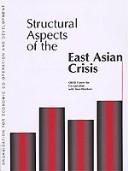| Listing 1 - 2 of 2 |
Sort by
|

ISBN: 926417043X 9786610033188 1280033185 9264172939 Year: 1999 Publisher: Paris Oecd Publications
Abstract | Keywords | Export | Availability | Bookmark
 Loading...
Loading...Choose an application
- Reference Manager
- EndNote
- RefWorks (Direct export to RefWorks)
The once booming dynamic economies in Asia were drawn into a whirlpool of business failures and economic devastation following the flotation of the Thai baht in July 1997, and the consequent collapse of asset prices and currency depreciations in several East Asian countries. High growth in these emerging market economies had masked important structural weaknesses that eventually triggered the economic slump now referred to as the Asia Crisis. To address the structural measures needed to restore sustained economic growth and stability in the crisis-affected countries, this book brings forth analyses and recommendations on the crisis from internationally respected economists and policy makers and the OECD. Overall, experts conclude that, to deal with the crisis and alleviate social distress, structural reforms of government, business and the financial sector must be undertaken rapidly. Such reforms must be established with a long-term view to protect these and other countries from future crises. Economic recovery in Asia is a high priority for the OECD. As an international organisation with experience across a broad range of structural issues, it is a unique forum for the exchange of views on national experiences with policy reforms and possible improvements in the functioning of financial markets. In November 1998, the OECD's Centre for Co-operation with Non-Members (CCNM) held the symposium that led to this publication. Experts from OECD Member and non-member economies attended the symposium. This publication assembles their contributions and provides insight into the possible role of the OECD in promoting economic recovery in the region.
economische crisis --- economische hervorming --- azie --- ASI / Asia - Azië - Asie --- 333.481 --- 331.32 --- crise economique --- reforme economique --- asie --- Monetaire crisissen, hervormingen, saneringen en stabilisering. --- Structuur van de economie. --- 338.95 --- East Asia --- -East Asia --- -Asia, East --- Asia, Eastern --- East (Far East) --- Eastern Asia --- Far East --- Orient --- Economic conditions --- -Economic conditions --- -Electronic information resources --- Economic policy --- -Economic policy --- Extrême-Orient --- Congresses --- Politique économique --- Congrès --- Conditions économiques --- Structuur van de economie --- Monetaire crisissen, hervormingen, saneringen en stabilisering --- Finance and Investment --- Business & Economics --- Economic History
Book
ISBN: 9782724611540 2724611543 Year: 2010 Volume: 18 Publisher: Paris Les presses de Sciences Po
Abstract | Keywords | Export | Availability | Bookmark
 Loading...
Loading...Choose an application
- Reference Manager
- EndNote
- RefWorks (Direct export to RefWorks)
Les effets de la crise accélèrent le déplacement du centre de gravité de l'économie mondiale vers l'Asie qui, en 2030, comptera trois des quatre premières puissances au monde : Chine, Japon et Inde. Pékin et Tokyo s'y disputent le leadership dans une compétition apparemment inégale. Irrésistible ascension d'une Chine dynamique et conquérante, déclin inéluctable d'un Japon anémié et vieillissant ? Face à cette vision d'un avenir tout tracé, l'auteur analyse avec précision leur légitimité respective à revendiquer la suprématie économique et stratégique dans une Asie en voie d'intégration, puis esquisse pour les vingt prochaines années le scénario qui lui paraît le plus probable. Un essai rigoureux et stimulant pour un débat qui ne peut laisser les Européens indifférents. Le destin de l'Europe, de ses industries et de ses universités se joue aussi à Pékin et à Tokyo, où s'ébauchent les contours d'une future Communauté asiatique.
International economic relations --- Geopolitics --- Relations économiques internationales --- Géopolitique --- East Asia --- China --- Japan --- Extrême-Orient --- Chine --- Japon --- Economic conditions --- Conditions économiques --- Foreign economic relations --- International economic relations. --- Foreign economic relations. --- Economic conditions. --- -International economic relations --- situation economique --- asie --- 337 --- Economic policy, Foreign --- Economic relations, Foreign --- Economics, International --- Foreign economic policy --- Interdependence of nations --- International economic policy --- International economics --- New international economic order --- Economic policy --- International relations --- Economic sanctions --- World politics --- economische toestand --- azie --- -East Asia --- -Japan --- Asia, East --- Asia, Eastern --- East (Far East) --- Eastern Asia --- Far East --- Orient --- -Economic conditions --- -Geopolitics --- Relations économiques internationales --- Géopolitique --- Extrême-Orient --- Conditions économiques --- Geopolitics - East Asia --- East Asia - Foreign economic relations --- East Asia - Economic conditions --- China - Economic conditions - 2000 --- -Japan - Economic conditions - 1989 --- Asian economics - China - Japan. --- Asie
| Listing 1 - 2 of 2 |
Sort by
|

 Search
Search Feedback
Feedback About
About Help
Help News
News